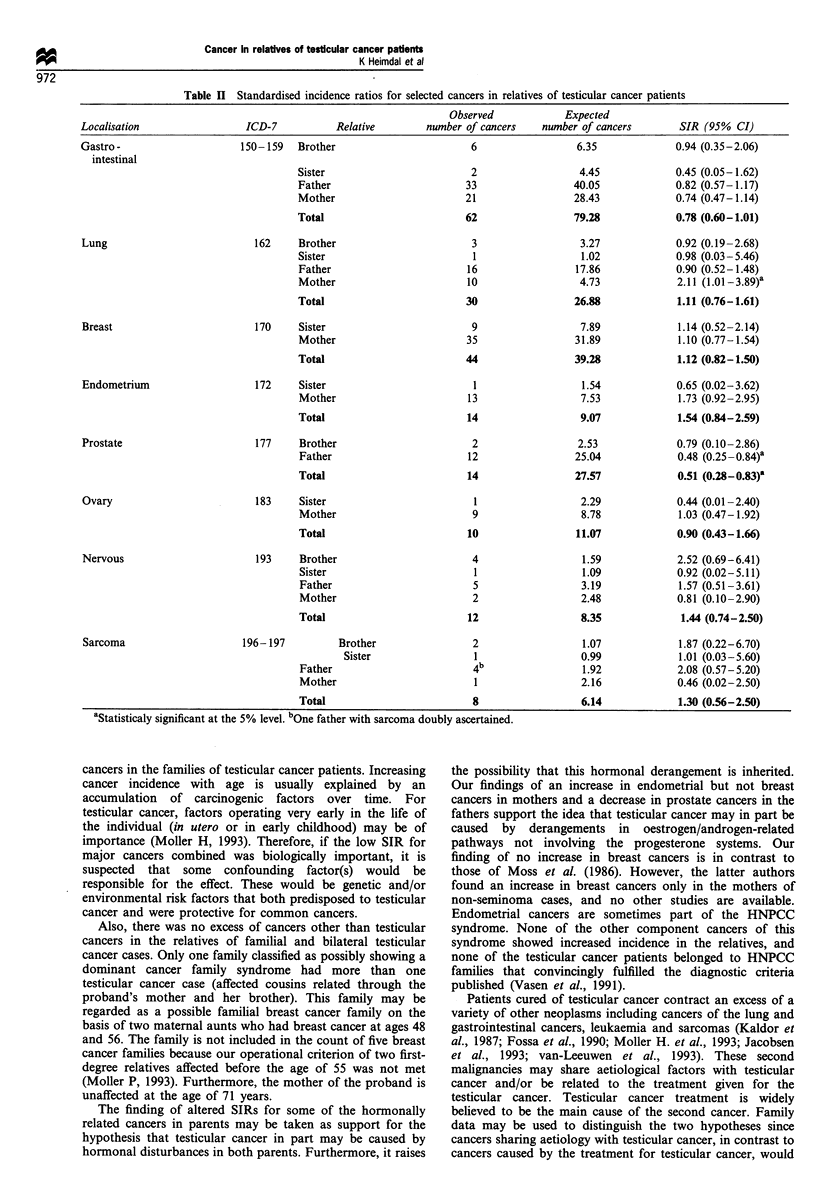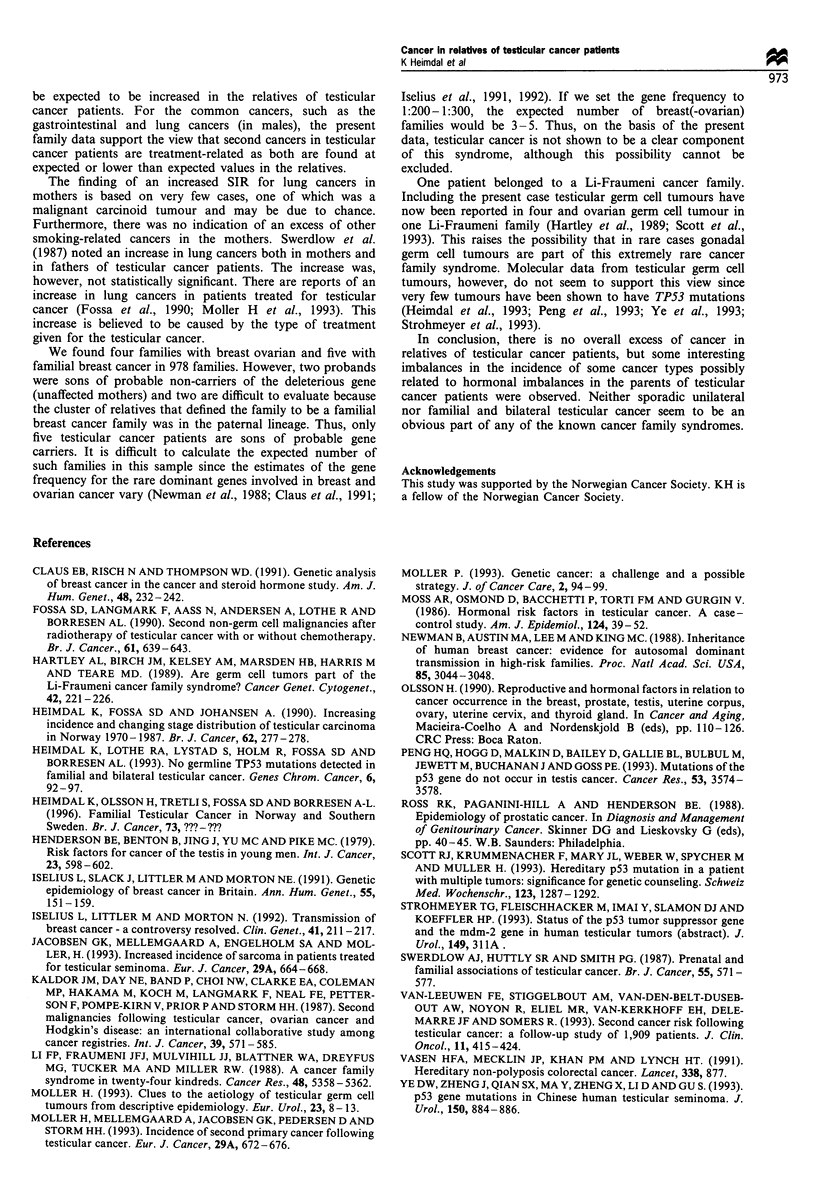Abstract
The incidence of cancer at sites other than the testis has been investigated in the families of 797 Norwegian and 178 Swedish patients diagnosed with testicular cancer during 1981-91. In the families of the Norwegian patients, the total number of cancers in the relatives was significantly lower than the expected number derived from national incidence rates [observed number of cancers 250, expected number of cancers 281.92, standardised incidence ratio (SIR) 0.89, 95% confidence interval (CI) 0.78-1.00]. This finding can be accounted for almost entirely by the finding of fewer than expected prostate and gastrointestinal cancers in the parents of cases. The other common cancers were found at slightly lower than or near the expected levels in the relatives. In the Swedish cohort, which accounts for less than 20% of cases, the observed number of cancers was very close to the expected number. Fourteen fathers of cases had prostate cancer compared with 27.57 prostate cancers expected, giving a SIR of 0.51 (P=0.006). Mothers had more lung cancers (ten cases observed, SIR=2.11, P=0.04) and cancers of the endometrium than expected (13 cases observed, SIR=1.73, P=0.09). These findings may be interpreted as support for theories proposing hormonal dysfunction as causing testicular cancer. Fifty-four gastrointestinal cancers were observed in the parents compared with 68.48 expected (SIR=0.78, P=0.082). Furthermore, testicular cancer was not found to be associated with the known dominantly inherited cancer syndromes [Familial breast (-ovarian) cancer, hereditary no-polyposis colon cancer]. However, one patient belonged to a Li-Fraumeni family, raising the possibility that testicular cancer may be an infrequent component of this rare cancer syndrome. This study supports the hypothesis that families of testicular cancer patients are not prone to cancer.
Full text
PDF



Selected References
These references are in PubMed. This may not be the complete list of references from this article.
- Claus E. B., Risch N., Thompson W. D. Genetic analysis of breast cancer in the cancer and steroid hormone study. Am J Hum Genet. 1991 Feb;48(2):232–242. [PMC free article] [PubMed] [Google Scholar]
- Fosså S. D., Langmark F., Aass N., Andersen A., Lothe R., Børresen A. L. Second non-germ cell malignancies after radiotherapy of testicular cancer with or without chemotherapy. Br J Cancer. 1990 Apr;61(4):639–643. doi: 10.1038/bjc.1990.142. [DOI] [PMC free article] [PubMed] [Google Scholar]
- Hartley A. L., Birch J. M., Kelsey A. M., Marsden H. B., Harris M., Teare M. D. Are germ cell tumors part of the Li-Fraumeni cancer family syndrome? Cancer Genet Cytogenet. 1989 Oct 15;42(2):221–226. doi: 10.1016/0165-4608(89)90090-3. [DOI] [PubMed] [Google Scholar]
- Heimdal K., Fosså S. D., Johansen A. Increasing incidence and changing stage distribution of testicular carcinoma in Norway 1970-1987. Br J Cancer. 1990 Aug;62(2):277–278. doi: 10.1038/bjc.1990.277. [DOI] [PMC free article] [PubMed] [Google Scholar]
- Heimdal K., Lothe R. A., Lystad S., Holm R., Fosså S. D., Børresen A. L. No germline TP53 mutations detected in familial and bilateral testicular cancer. Genes Chromosomes Cancer. 1993 Feb;6(2):92–97. doi: 10.1002/gcc.2870060205. [DOI] [PubMed] [Google Scholar]
- Henderson B. E., Benton B., Jing J., Yu M. C., Pike M. C. Risk factors for cancer of the testis in young men. Int J Cancer. 1979 May 15;23(5):598–602. doi: 10.1002/ijc.2910230503. [DOI] [PubMed] [Google Scholar]
- Iselius L., Littler M., Morton N. Transmission of breast cancer--a controversy resolved. Clin Genet. 1992 Apr;41(4):211–217. doi: 10.1111/j.1399-0004.1992.tb03665.x. [DOI] [PubMed] [Google Scholar]
- Iselius L., Slack J., Littler M., Morton N. E. Genetic epidemiology of breast cancer in Britain. Ann Hum Genet. 1991 May;55(Pt 2):151–159. doi: 10.1111/j.1469-1809.1991.tb00408.x. [DOI] [PubMed] [Google Scholar]
- Jacobsen G. K., Mellemgaard A., Engelholm S. A., Møller H. Increased incidence of sarcoma in patients treated for testicular seminoma. Eur J Cancer. 1993;29A(5):664–668. doi: 10.1016/s0959-8049(05)80342-9. [DOI] [PubMed] [Google Scholar]
- Kaldor J. M., Day N. E., Band P., Choi N. W., Clarke E. A., Coleman M. P., Hakama M., Koch M., Langmark F., Neal F. E. Second malignancies following testicular cancer, ovarian cancer and Hodgkin's disease: an international collaborative study among cancer registries. Int J Cancer. 1987 May 15;39(5):571–585. doi: 10.1002/ijc.2910390506. [DOI] [PubMed] [Google Scholar]
- Li F. P., Fraumeni J. F., Jr, Mulvihill J. J., Blattner W. A., Dreyfus M. G., Tucker M. A., Miller R. W. A cancer family syndrome in twenty-four kindreds. Cancer Res. 1988 Sep 15;48(18):5358–5362. [PubMed] [Google Scholar]
- Moss A. R., Osmond D., Bacchetti P., Torti F. M., Gurgin V. Hormonal risk factors in testicular cancer. A case-control study. Am J Epidemiol. 1986 Jul;124(1):39–52. doi: 10.1093/oxfordjournals.aje.a114369. [DOI] [PubMed] [Google Scholar]
- Møller H., Mellemgaard A., Jacobsen G. K., Pedersen D., Storm H. H. Incidence of second primary cancer following testicular cancer. Eur J Cancer. 1993;29A(5):672–676. doi: 10.1016/s0959-8049(05)80344-2. [DOI] [PubMed] [Google Scholar]
- Newman B., Austin M. A., Lee M., King M. C. Inheritance of human breast cancer: evidence for autosomal dominant transmission in high-risk families. Proc Natl Acad Sci U S A. 1988 May;85(9):3044–3048. doi: 10.1073/pnas.85.9.3044. [DOI] [PMC free article] [PubMed] [Google Scholar]
- Peng H. Q., Hogg D., Malkin D., Bailey D., Gallie B. L., Bulbul M., Jewett M., Buchanan J., Goss P. E. Mutations of the p53 gene do not occur in testis cancer. Cancer Res. 1993 Aug 1;53(15):3574–3578. [PubMed] [Google Scholar]
- Scott R. J., Krummenacher F., Mary J. L., Weber W., Spycher M., Müller H. Vererbbare p53-Mutation bei einem Patienten mit Mehrfachtumoren: Bedeutung für die genetische Beratung. Schweiz Med Wochenschr. 1993 Jun 26;123(25):1287–1292. [PubMed] [Google Scholar]
- Swerdlow A. J., Huttly S. R., Smith P. G. Prenatal and familial associations of testicular cancer. Br J Cancer. 1987 May;55(5):571–577. doi: 10.1038/bjc.1987.116. [DOI] [PMC free article] [PubMed] [Google Scholar]
- Ye D. W., Zheng J., Qian S. X., Ma Y., Zheng X., Li D., Gu S. p53 gene mutations in Chinese human testicular seminoma. J Urol. 1993 Sep;150(3):884–886. [PubMed] [Google Scholar]
- van Leeuwen F. E., Stiggelbout A. M., van den Belt-Dusebout A. W., Noyon R., Eliel M. R., van Kerkhoff E. H., Delemarre J. F., Somers R. Second cancer risk following testicular cancer: a follow-up study of 1,909 patients. J Clin Oncol. 1993 Mar;11(3):415–424. doi: 10.1200/JCO.1993.11.3.415. [DOI] [PubMed] [Google Scholar]


